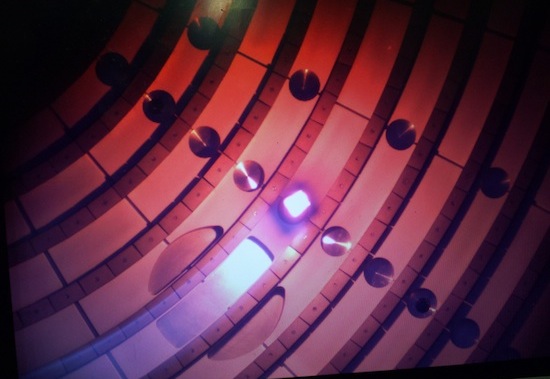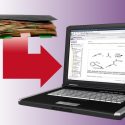Scientists begin effort to stir up a cosmic dynamo in the lab

A heated electron emitting cathode (the bright spot at center) lights up the interior of a three-meter cast aluminum sphere used to contain plasmas, in an effort to create the kind of dynamo observed at the center of the Earth, sun and many other types of stars.
Photo: Cary Forest laboratory
For scientists trying to understand the subtleties of cosmic dynamos — the magnetic field-inducing phenomena at the hearts of planets, stars and galaxies — the physics, for the most part, must be done at vast distances.

Forest
Soon, however, instead of probing dynamos on distant stars or at the inaccessible core of the Earth, scientists may be able to put dynamos under the proverbial microscope as physicists at UW–Madison are on the verge of creating a plasma dynamo in the lab. The ability to create dynamos that accurately mimic those that occur in nature promises to reveal the underlying mysteries of cosmic dynamos and how they generate huge, powerful magnetic fields.
“Now, we study these astrophysical dynamos by observing them and through computer modeling based on imperfect theory,” explains Cary Forest, a physics professor leading the new experimental effort. “Physics, ultimately, is an experimental science, and we need devices where we can turn knobs to test theories.”
Dynamos, Forest says, are electrical generators. They are either human contrivances or natural phenomena that can generate electricity from motion. “With electric currents come magnetic fields,” says Forest, noting that the sun, a plasma, generates a magnetic field that we observe as sun spots or solar flares that sometimes lash the Earth, creating all kinds of electromagnetic havoc.
The device at the heart of the new effort is a specially built three-meter diameter hollow aluminum sphere. Lined with 3,000 powerful rare earth magnets, the vessel is intended to contain and stir plasmas heated to 500,000 degrees Fahrenheit.
The Earth’s dynamo is critical not only because it generates a magnetic field that helps us find north, but also because the field it generates stretches from the inner core of our planet to space where it creates the magnetosphere and deflects the solar wind.
Over the course of the past two weeks, Forest and his group have generated a series of brief plasma events, each lasting about one second. Plasmas are gases heated to the point where electrons shake free from their nuclei and therefore are free to carry electrical current, an intrinsic characteristic of the magnetic fields generated by cosmic dynamos.
The Earth’s dynamo is critical not only because it generates a magnetic field that helps us find north, but also because the field it generates stretches from the inner core of our planet to space where it creates the magnetosphere and deflects the solar wind. Without that deflective magnetic power, the solar wind would destroy the ozone layer and leave us exposed to searing ultraviolet rays from the sun.
On Earth, the geodynamo is spun to life in a swirl of molten iron at the core of the planet. Until the last century, the Earth’s was the only known cosmic magnetic field. But scientists have since discovered magnetic fields emanating from the sun, other planets, a variety of star types and star clusters. Even entire galaxies are now known to generate magnetic fields, which stretch for vast distances — tens of thousands of light years.
A critical question for scientists, and one Forest and his group hope to tease out of their experimental work, is how cosmic dynamos arise to begin with. “Creating a plasma dynamo in the lab allows us to vary the conditions that make it work, and we can observe how, when and why dynamos come into being,” Forest says. “And we can make measurements that just aren’t available through observation. For example, it is impossible to send a satellite into the sun to measure the magnetic field deep inside. It is possible to put a probe into our plasma dynamo experiment.”
The new Wisconsin experiment, Forest adds, will also help refine theory and improve the computer models scientists have devised to simulate cosmic dynamos.
“Computers can’t simulate the sun, for example, because it is so large and computers do not have the speed or memory to do so. But our experiment, while able to generate magnetic fields, can actually be modeled by computers and those models can be tested directly.”



